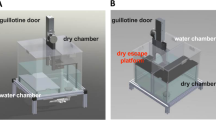Abstract
Ben-Ami Bartal et al. (Science 334:1427–1430, 2011) showed that a rat in an open space (free rat) would touch the front door of a restraining tube to open its rear door, thereby enabling a rat trapped within (trapped rat) to enter a larger space that was farther away from the free rat. Since opening the rear door distanced the trapped rat from the free rat, Ben-Ami Bartal et al. argued free-rat behavior could not be motivated by the pursuit of social contact. Instead, this rat was empathically motivated, its goal being to reduce the presumed distress of the rat trapped in the restraining tube. In two experiments, we show that (a) a free rat will not learn to touch the front door to open the rear door when it is the first condition of the experiment; (b) over time, a trapped rat will often return to a restraining tube despite its presumed aversiveness; and (c) a free rat experienced in touching the front door will continue to touch it even if touching does not free the trapped rat. We explain these results and Ben-Ami Bartal et al.’s in terms of two processes, neophobia and the pursuit of social contact. When first placed in a restraining tube, neophobia causes the trapped rat to escape the tube when the rear door is opened. Across sessions, neophobia diminishes, permitting the rats’ pursuit of social contact to emerge and dominate free- and trapped-rat behavior.






Similar content being viewed by others
References
Ben-Ami Bartal I, Decety J, Mason P (2011) Empathy and pro-social behavior in rats. Science 334:1427–1430
Brosnan SF, de Waal FBM (2003) Monkeys reject unequal pay. Nature 425:297–299
Burkart JM, Fehr E, Efferson C, van Schaik CP (2007) Other-regarding preferences in a non-human primate: common marmosets provision food altruistically. Proc Natl Acad Sci USA 104:19762–19766
Chen MK, Lakshminarayanan V, Santos LR (2006) How basic are behavioral biases? Evidence from capuchin monkey trading behavior. J Polit Econ 114:517–537
Colman AD, Liebod KE, Boren JJ (1989) A method for studying altruism in monkeys. Psychol Rec 19:401–405
Cowan PE (1977) Neophobia and neophilia: new-object and new-place reactions in three Rattus species. J Comp Physiol Psychol 91:63–71
de Waal FBM (2012) The antiquity of empathy. Science 336:874–876
de Waal FBM, Leirngruber K, Greenberg AR (2008) Giving is self-rewarding for monkeys. Proc Natl Acad Sci USA 105:13685–13689
Decety J, Norman GJ, Berntson GG, Cacioppo JT (2012) A neurobehavioral evolutionary perspective on the mechanisms underlying empathy. Prog Neurobiol 98:38–48
Ennaceur A, Michalikova S, Chazot PL (2009) Do rats really express neophobia towards novel objects? Experimental evidence from exposure to novelty and to an object recognition task in an open space and an enclosed space. Behav Brain Res 197:417–434
Fontenot MB, Watson SL, Roberts KA, Miller RW (2007) Effects of food preferences on token exchange and behavioural responses to inequality in tufted capuchin monkeys, Cebus apella. Anim Behav 74:487–496
Jensen K, Hare B, Call J, Tomasello M (2006) What’s in it for me? Self-regard precludes altruism and spite in chimpanzees. Proc R Soc B 273:1013–1021
Lakshminarayanan VR, Santos LR (2008) Capuchin monkeys are sensitive to others’ welfare. Curr Biol 18:R999–R1000
Latané B, Glass DC (1958) Social and nonsocial attraction in rats. J Pers Soc Psychol 9:142–146
Masserman JH, Wechkin S, Terris W (1964) “Altruistic” behavior in rhesus monkeys. Am J Psychiatry 121:584–585
Mitchell D (1976) Experiments on neophobia in wild and laboratory rats: a reevaluation. J Comp Physiol Psychol 90:190–197
Nowbahari E, Scohier A, Durand J-L, Hollis KL (2009) Ants, Cataglyphis cursor, use precisely directed rescue behavior to free entrapped relatives. PLoS ONE 4:e6573. doi:10.1371/journal.pone.0006573
Panksepp J (2011) Empathy and the laws of affect. Science 334:1358–1359
Povinelli DJ, Perilloux HK, Reaux JE, Bierschwale DT (1998) Young and juvenile chimpanzees’ (Pan troglodytes) reactions to intentional versus accidental and inadvertent actions. Behav Process 42:205–218
Preobrazhenskaya IA, Simonov PV (1974) Conditioned avoidance response to the pain stimulation of another animal. Sov Psychol 12:90–101
Rice GE, Gainer P (1962) Altruism in the albino rat. J Comp Physiol Psychol 55:123–125
Sidman M (1960) Tactics of scientific research: evaluating experimental data in psychology. Basic Books, New York
Silberberg A, Roma PG, Huntsberry ME, Warren-Boulton FR, Sakagami T, Ruggiero AM, Suomi SJ (2008) On loss aversion in capuchin monkeys. J Exp Anal Behav 89:145–155
Silk JP, Brosnan SF, Vonk J, Henrich J, Povinelli DJ, Richardson AS, Lambeth SP, Mascaro J, Schapiro J (2005) Chimpanzees are indifferent to the welfare of unrelated group members. Nature 437:1357–1359
Vasconcelos M, Hollis K, Nowbahari E, Kacelnik A (2012) Pro-sociality without empathy. Biol Lett 8:910–912
Warneken F, Tomasello M (2006) Altruistic helping in human infants and young chimpanzees. Science 311:1301–1303
Wolfle DL, Wolfle HM (1939) The development of cooperative behavior in monkeys and young children. J Genet Psychol 55:137–175
Woodruff G, Premack D (1979) Intentional communication in the chimpanzee—development of deception. Cognition 7:333–362
Author information
Authors and Affiliations
Corresponding author
Rights and permissions
About this article
Cite this article
Silberberg, A., Allouch, C., Sandfort, S. et al. Desire for social contact, not empathy, may explain “rescue” behavior in rats. Anim Cogn 17, 609–618 (2014). https://doi.org/10.1007/s10071-013-0692-1
Received:
Revised:
Accepted:
Published:
Issue Date:
DOI: https://doi.org/10.1007/s10071-013-0692-1




